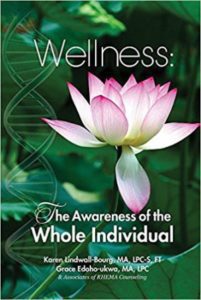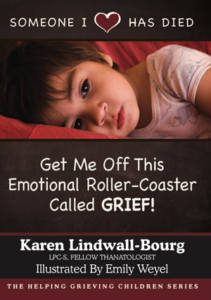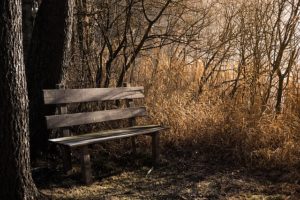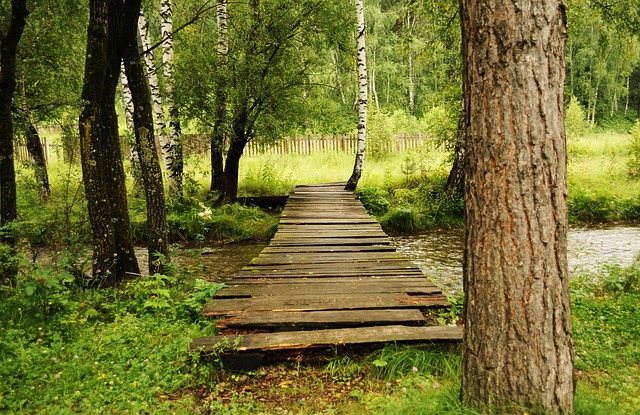
by Karen Lindwall-Bourg | Oct 28, 2020 | Blog, Writing & Publishing
Grief: There is no “Right Way” to Grieve
Grief Defined (Miriam Webster)
A deep sadness caused especially by someone’s death, a cause of deep sadness.
The conflicting feelings caused by the end of or change in a familiar pattern of behavior.
When someone important to us dies, it represents an end to what has been familiar for us, and we must adapt to that new—usually unwanted—reality.
I would add to “usually unwanted reality” surprised and possibly shocking reality.
My First Grief Experiences
When I was 17 and my brother was 14, our dad died suddenly. He had just started work for a new company, we were starting our Christmas decorations for that year, and life seemed to be rolling along for our family. Then everything changed, suddenly and shockingly.
As a 17 year-old, the only death I’d experienced—the first true grief—was that of my grandfather the year before. He lived across the state from us, and when he died, our family went. At least, most of the family; I stayed behind. I didn’t want to remember Granddaddy any other way than how I last saw him—so my parents let me stay home. Maybe they figured I’d need to work out my grief in my own way.
So when my dad died almost a year to the day later, I began to experience grief in a whole new light. I watched my strong, independent, “drill sergeant” mom fall apart; over the next days and weeks, she didn’t sleep, she had phantom illnesses, she stared into space for hours. My brother—who up to that point had been a fairly happy-go-lucky guy—over the next several months, became angry and rebellious and would often rage over small things.
Grief—there is no one way or right way to experience it.
As for my reaction to Dad’s sudden death—I pretty much remained calm and strong for everyone else. Because Dad was a WWII veteran, there would be no funeral or service for several weeks (his body was cremated) until our family could get to the National Cemetery. So for me, life went on. I picked up the slack around the house, I tried to calm my brother down, I went with Mom to the hospital when she thought something was wrong. My school choir was in the middle of rehearsals for a Christmas performance, so I went to rehearsal. I stayed busy with school and at home, and I spent a lot of time in my room, alone with my guitar.

There is Help.
Someone I Love Has Died: Everyone Grieves and No One Grieves Like Me is a book where children can read about how grief is personal and individual for everyone; that there isn’t one way to grieve or to feel, that it is a process each person walks through differently. The coloring pages are available for filling in or doodling or writing, showing how unique grief is to each of us.
In this book, author Karen Lindwall-Bourg also gives parents and care-givers tools with which to help guide children through their own grief process. “Written for grieving children, ages 3-99, and for those who walk this journey with them,” this little book will help people of all ages understand that grief isn’t static and that each person grieves in his or her unique way.
By Lee Desmond, originally posted on Rhema Publishing House

by Karen Lindwall-Bourg | Oct 28, 2020 | Blog, Writing & Publishing
Wellness: Renewal of the Whole Person
Do not be conformed to this world, but be transformed by the renewal of your mind …
—Romans 12:2a (ESV, emphasis added)
Transform : make a thorough or dramatic change in the form, appearance, or character of.
Renewal : the replacing or repair of something that is worn out, run-down, or broken.
We all need to make changes from time to time, and often those changes need to be thorough and dramatic, going from unhealthy to healthy, from broken to renewed.
To wellness.
Parts—or thoughts—may need to be replaced, transformed, and revived. So how do we make those life changes? How do we get to wellness?
Beliefs
Wellness: The Awareness of the Whole Individual focuses on the acronym BELIEFS. Each chapter highlights one area of BELIEFS and ends with an assessment for help in determining areas in life that may need attention. True wellness should be cultivated in key areas of our lives:
- Body
- Emotions
- Livelihood
- Intellect
- Environment
- Family & Friends
- Spiritual
The necessity of health and wellness is before us constantly—on social media, on billboards, in magazines we see in the grocery check-out line, on television. Our culture is obsessed with the latest health food, living a stress free life, the easiest and guaranteed-to-work diet plan. And yet, wellness is about so much more than only the physical. Each of these areas is important in providing peace and rest for our souls.
For as he thinks within himself, so he is. —Proverbs 23:7 (NASB)
A friend of mine, who recently became a Life Coach, instructs her clients that they control and direct their emotions by controlling and directing their thinking. Likewise, in each of these areas of BELIEFS, we have the ability to make choices toward wellness and health.
“A healthy outside starts from the inside.” —Robert Urich
Because we live in a fallen world, the storms of life will come our way. This encouraging and practical book helps to navigate through those storms, pointing us toward a life of wholeness and wellness while we’re on this earth.
“The part can never be well unless the whole is well.” —Plato

By Lee Desmond, originally posted by Rhema Publishing House

by Karen Lindwall-Bourg | Oct 28, 2020 | Blog, Writing & Publishing
Roller Coaster of Grief
When I was younger, I loved riding roller coasters at the State Fair; I’d go every year with just enough money to buy lunch and ride the roller coaster a couple of times. But it wasn’t that way the very first time I rode one—my friends had to coax me on, and once it was over, they had to help me off!
Grief is often like a roller coaster ride.
Ups, Downs and Everything in Between
Life events are often a lot like that first roller coaster ride, especially when a loved one dies. Like that first coaster ride, with its ups, downs, twists, turns, smooth and rough spots—and not knowing what comes next—emotions and grief are unpredictable, and the feelings that come and go and change, can be confusing and scary.
Recently, I heard a news story about a roller coaster that stopped in mid-air. The riders hung upside down for three hours before the mechanics could repair the machinery and get them down. Can you imagine? Thankfully, no one was injured—but I bet it got them to thinking twice about riding that coaster again for a long while!
Unfortunately, when someone we love dies, we don’t have the choice to refuse the roller coaster ride of emotions. And “the death of someone we love is definitely not … a journey we would choose to go on.”
How to Ride the Roller Coaster of Grief
In Someone I Love Has Died: Get Me OFF This Emotional Roller Coaster Called Grief, author Karen Lindwall-Bourg walks us through her and her children’s own experiences after losing someone they loved. She helps the reader understand how different grief is for each person going through it; that all of the ups, downs and turn-arounds are completely normal; and that the ride WILL stop at some point. This booklet is for anyone struggling to understand that roller coaster called Grief. Children, parents, care-givers—anyone grieving the death of a loved one—will walk off that ride with renewed strength to carry on.

By Lee Desmond, originally posted on Rhema Publishing House

by Karen Lindwall-Bourg | Oct 28, 2020 | Blog, Writing & Publishing
Tyranny Of The Good
“Sometimes saying ‘No’ is the only way back to a life of ‘Yes.’” —Shauna Niequist
All things are lawful, but not all things are profitable. All things are lawful, but not all things build up.—I Corinthians 10:23
Good Things
Have there been times in your life, maybe even now, when you are doing good things—really good things, LOTS of good things—but you realize that something isn’t quite right? If you’re like me, the answer is a resounding “YES!” If we’re honest, most of us walk…or run really fast…that pathway more often than not. We get busy doing activities or jobs that are productive and helpful and serving others and life-giving. Why would we NOT want to do those things??
When our family moved from our beloved east Texas to Colorado several years ago, I felt that if I didn’t get involved and be of service and make friends pretty quickly, I might sink. We had left the place where we raised our children and ourselves; where we helped start a church, served in the community, and were involved in myriad home school activities; we left friends we did life with and with whom we developed roots. Because I had been doing all of these good things, before we got unpacked, I started putting my name on lists, volunteering for needs at church, and looking for people who were in the same life-vein as I was.
All of those things were good!

STOP! Slow Down!
But about a year after we got settled in CO, something—or Someone—spoke to me. “Slow down. Stop striving. Rest.” Then, “You will be just fine—even better. Get to know yourself and love those who are most important in your life right now. All of those other activities and needs and people aren’t going anywhere—but the most important ones are right in front of you. THIS is where you need to be.”
“STOP! Get to know yourself and love those who are most important in your life right now.” What?! Wasn’t I doing that? Hadn’t I done that all along? I was already doing that by staying busy with all the good things and people around us, while also teaching my children about service and what was important. What does that mean, “Get to know yourself”??
Tyranny of the Good
Somewhere along the way of life, where so many good things were before me, I thought I had to do them all and work to make sure things got done. I had to serve because there were so many needs, and surely, no one else would do the job; or because others expected me to do it; or maybe because it made me feel important. Really? Rather than pray over all of those good tasks (there’s a concept!) before deciding what was best for all concerned—especially my family andme—I took off running. I loved what I was doing: working, teaching, leading, heading up hospitality committees, attending to others’ needs.
Although I thought my busyness and service were necessary and good, they weren’t best. The work I was doing wasn’t always profitable—I was striving, and the good things I was doing became a kind of tyranny. The goodness of life, while always a gift, had started to become a very heavy weight; and before I realized it, I was on a track where knowing God, knowing myself, and knowing those I love most, had taken a back seat.
Saying No
Soon after I heard that voice telling me to slow down and “get to know myself” and to truly connect with and love those around me, I started saying “No.” I said No when I was asked to manage a website for something at church; No when a need was posted for a co-op leader; Nowhen asked to volunteer weekly at a food bank. All of these needs were important, necessary, and good—and it wasn’t easy using the N word (at first). But eventually, I gained a freedom that was even more important, necessary, meaningful—and so much better.
Gradually, I started saying Yes to quiet mornings at home, to writing more, to deep and important conversations with my adult children; Yes to serving those in my home. I had to learn No so I could get back to Yes.
In the process, I slowly began to realize things about myself and understand more of what God wanted me to know: that He will use me right where I am; I don’t need to chase after all of those good things in life I am not responsible for; He directs my path toward goodness as long as I seek Him first.

He who dwells in the shelter of the Most High
will abide in the shadow of the Almighty. Psalm 91:1
Return to your rest, my soul, for the Lord has been good to you. Psalm 116:7
Return to Your Rest
Once you find the Rest your soul needs, you’ll realize that Life is still there, all of those good things are still waiting. Eventually, you will also be able to discern what is profitable. When you’re able to step back and see not only what the world around you needs, but what YOU need, you’ll walk toward to a more healthy and whole path and will be able to say Yes once again.
“In returning and rest you shall be saved; in quietness and in trust shall be your strength.”
—Isaiah 30:15
By Lee Desmond, Originally Posted on Rhema Publishing House











